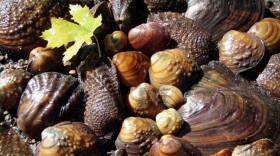One of the many wonderful things about summer is the arrival of fresh and tasty local fruits. I am sure we all buy strawberries, raspberries and blueberries at the grocery store or maybe even go to a Pick-Your-Own berry farm. But these fruits are all native to Wisconsin and we can find them growing wild. They tend to be smaller, but more flavorful than their cultivated cousins, and may or may not be worth the trouble to gather in the wild.
Strawberries, raspberries and blackberries are all in the Rose family, Rosaceae, and this plant family is a treasure trove of delicious edible fruits. It also includes cherries, apples, pears, peaches, apricots, and almonds.
All strawberries are in the Fragaria genus within the Rose Family. Commercial strawberries, including the yummy pick your own strawberries, started out as a combo species of Fragaria; a hybrid of our own Fragaria virginiana and Fragaria chiloensis, from Chile. Now there are many cultivars for commercial propagation.
Wisconsin’s native species of strawberries are the Virginia Strawberry, Fragaria virginiana, and the Woodland Strawberry, Fragaria vesca. They are rather hard to tell apart, although the Virginia strawberry fruit is roundish, while the Woodland is more elongate. Both are found throughout Wisconsin, and both grow here in the Northwoods. As with all fruits, the strawberry plant has to first flower, before it can make fruits. Both of our wild strawberries have flowers with five white petals and are mostly pollinated by bees. Once pollinated, the juicy red fruit starts to develop. But the strawberry is not actually a berry at all. Botanically, it is an aggregate fruit, and what we are eating is the enlarged receptacle, or flower stalk. For many flowers, the receptacle is the part of the plant where the petals attach, but in the strawberry this gets expanded to become the red, juicy deliciousness we eat. The actual “fruit” of the strawberry, the part of the plant that holds the seeds, are the little pips on the outside of the red part. These pips are achenes, a kind of dry fruit, and the seeds for new strawberries are inside the little achenes.
Raspberries and blackberries are also in the Rose Family and both are in the genus Rubus. Red raspberry, Rubus ideaeus, is also found in Europe. The name ideaus refers to Mt. Ida in Crete where Jupiter was hidden as an infant. Both raspberries and blackberries are found throughout much of Wisconsin. These fruits are not actually berries, either, but are aggregate fruits. Each one of the little juicy balls, or drupelets, is a fruit with a tiny seed inside that get stuck in your teeth. Black raspberries are also found in Wisconsin, though they are not as widely found in the North. Black raspberries are hollow inside and blackberries have a white core, but otherwise are similar in appearance.
Blueberries are not in the Rose family, but are in the Blueberry Family, Ericaceae. This is also home to cranberries, bilberries, lingonberries and huckleberries. Cranberries are not only cultivated up here in the Northwoods, but are common in our bogs. Lingonberries are native across the Northern Hemisphere throughout the boreal, or fir and spruce forests and arctic tundra. Bilberries are native to Europe.
Those species are all in the Vaccinium genus, but Huckleberries are in the Gaylussacia genus, Huckleberries look like extra-large blueberries, but are more tart and have larger, crunchier seeds inside. They are native throughout much of the Northern United States and Canada, although I don’t see them too often in the Northwoods. Huckleberries are far less often cultivated than blueberries.
Unlike those other “imposter” berries, blueberries are "true berries," meaning they develop from a single flower with one ovary. We have two species here in the Northwoods, including lowbush blueberries, Vaccinium angustifolium and highbush blueberries, Vaccinium corymbosum. The highbush blueberry is a taller shrub, with larger fruits and is the most commonly cultivated species. The lowbush blueberry fruits are smaller, with a more intense flavor. Although we have plenty of lowbush blueberries in Wisconsin, the state of Maine is the epicenter of naturally growing lowbush blueberries.
Many studies, including human clinical trials have found red, blue and purple fruits, which are naturally high in chemicals called anthocyanins, possess properties that are kind of good for whatever ails you. They have antioxidative and antimicrobial activities, protect against some non-contagious diseases, and can even improve your eyesight and brain function. The main effect of these anthocyanins is to scarf up free radicals, molecules that can damage parts of your cells such as your DNA. These berries are also stuffed with vitamins making them some of the healthiest foods around.
So eat up our delicious fruits of summer. So tasty and so good for you!








